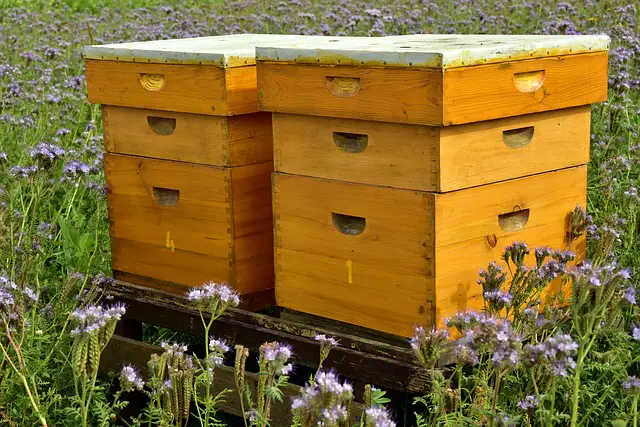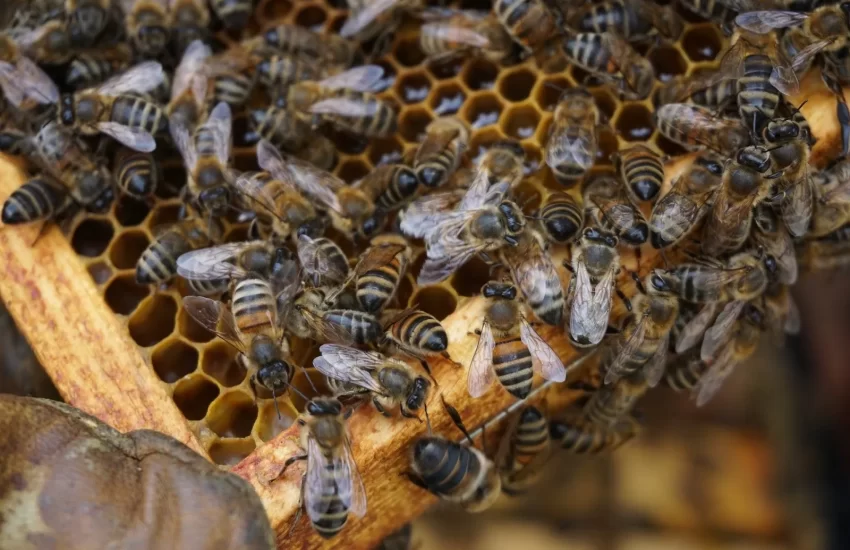How to Move a Beehive Without Losing Bees?
Moving bees the right way is an essential skill for every beekeeper. Sometimes you will need to move your colonies for short or long distances. The method you use depends on how far you are moving your colony. Bees are habitual creatures; relocating disrupts them. It is vital to know how to move your bee colonies without losing these fantastic creatures.
Similar Articles you may like to read –
What time of the day is best to move a hive?
Why do beekeepers remove the queen?
What does a bee sting look like in the skin? How to remove it?
How to get rid of Hives? On arm? Should it be removed Overnight?
Some Reasons Why You May Need to Move Your Beehives
- When moving to a new location and want to carry your buzzing friends along
- When your colony is in danger of predators such as skunks and bears and you want to move them to a safer location
- When you want to rearrange and renovate your garden
- When you want to reposition your hive due to harsh winds, direct sunlight, or rain
- When you want to shift your bees to the nectar and pollen flows some distance away.
How Bees Orientate
Bees can forage up to a radius of 3-5 miles and make their way back to their home. They use landmarks and features like posts, fences, trees, and bushes to orientate themselves back to the hive. They also use polarized light to evaluate the relative speed of the landscape passing beneath them. An internal honing device that works like a GPS helps them orient by magnetic variations around them. Once the surrounding map is set in their memory, they don’t need to re-orientate every day. They already know how to get home once they leave the hive.
How to Move a Beehive Without Losing Bees
Moving beehives safely requires proper timing and planning. You can move a hive for long distances (more than 3 miles- greater than their foraging radius) or short distances ( less than 3 feet) without problems. You will not worry about them going to their old home. However, when you move them for a distance of less than 3 miles and more than 3 feet, they need help to re-orientate and adjust to the new area.
Materials needed
- A smoker
- Ratchet straps
- Screen or mesh
- A Pick-up or truck for long distances
- Beekeeping gear( suit, veil, and gloves)
- Duct tape
Moving Hives for Short Distance (3 Feet or Less)
When moving your beehive for this short distance, you can do it at any time of the day. Workers bees away foraging will be disoriented a bit but will still find their new home since it is near. They also use the odor or scent from the hive to locate it. The local features are also the same. However, you should not put another hive in the original location. To ease the process for the bees, the hive should face the same direction it was in its former spot. Closing and securing the hive may not be necessary. However, you should gear up and carry your smoker.
Moving a Hive More Than 3 Feet and Less than 3 Miles
Surprisingly, it is harder to move bee colonies for intermediary distances than long and short distances. Here are various ways you can employ while moving your hive at a distance of less than 3 miles and more than 3 feet.
Moving the Beehive to the Desired Location with an Obstruction at the Entrance
This method involves placing an obstruction such as a tree branch, a towel, or a colored board at the hive entrance. As the bees crawl through the entrance, through the obstacle, they will realize a change of environment and be forced to re-orientate their navigation map.
Moving the Beehive 3 Feet at a Time
This method involves moving the beehive 3 feet or less daily until you reach the desired location. It is also known as inching. It works well for some instances, but it is quite challenging for others. Obstructions such as slopes, fences, and roads, can hinder the movement. You can move the hive any time of the day. Most beekeepers prefer to move the hive when foragers are away in the middle of the day. Their absence reduces distraction, and the hive is also lighter. A hive barrow with a level platform is ideal instead of lifting the hive daily. You also require a plan for the moving route.
Caution:
If there are other hives close to the original home, you risk losing the worker bees to other colonies. This method works well on solitary beehives.
Relocating the Beehive to a Long Distance and Bringing them to the Desired Location
This method works quite well. It entails moving the beehive for longer distances greater than their foraging distances for a week or so and then bringing them back to the desired location on your farm. The unfamiliar location will trigger them to re-orientate and set their navigation map. Once you bring them back to your farm, the once-familiar landmarks will be new to them, and they will adjust accordingly. You should move the nest after dark or early in the morning when the foragers are in the hive.
Relocating the Beehives More than 3 Miles (Long Distances)
When moving the bees for long distances(more than their foraging radius), there is no worry about the bees returning to their original home. They will immediately reset their memory and start the process of discovering their new environment. Moving them in a comfortable environment makes the transition smooth and helps them quickly adapt to the new environment.
The perfect time to move the beehives is after dark or early in the morning when all foragers are in the hive. You should also ensure the hive is well ventilated. In the summer season, beehives get overheated quickly. The heat can cause the melting and collapse of combs and the death of bees.
While transporting them in hot weather, make a few quick stops to spray some plain water or a mix of sugar water through the mesh to cool them. You should avoid drenching the bees in water.
Process of Relocating Hives to Long Distances
Smoke the Hives’s Entrance
You may consider smoking the hive to calm the bees.
Close the Entrance, Holes, and Cracks on the Hive
This ensures the buzzing dearies don’t get out during transit.
Strap up the Hive
You should strap up the hive components securely so that they don’t fall apart while relocating.
Move the hive to the Back of the Vehicle.
A pick-up truck is an ideal option to move your hive. Well-established hives are quite heavy, and you will need a helping hand to lift them in and out of the vehicle. Ensure the beehive is well secured on the vehicle not to slide around. A hand truck can also help you to lift the hive into the vehicle.
Drive into the new Location
Drive carefully at moderate speed to minimize vibrations. Rough movement can dislodge the brood comb or even remove the seal from the entrance.
Unloading the Hive
You should carefully unload the hive from the vehicle and place it on the new hive stand. Once done, open the entrance. The bees will find themselves in a new environment and will work to adjust their navigation maps.
Precautions When Moving Beehives
Ventilation
You should ensure the hive is well ventilated before embarking on your journey since too much heat will kill the bees. You may end up with dead bees if not cautious. When closing up your hive to transport, make sure the air can circulate well. If your hive has a screened bottom board, ventilation is taken care of well. Ensure they are out of the sun if they are confined from transport for long hours.
A hive full of bees can overheat very quickly; hence it is good to spray some water at the entrance, especially in summer.
Ensure Bees Get Used to the New Home
Honey bees are oriented to their hives. When moving a beehive, you want to ensure they get used to their new location and not return to their old home. Luckily, if you move the hive more than 3 miles, they will not return to their old location since they will not recognize the area. If moving for a short distance, you need to take the necessary measures.
Shut the Door
When moving a beehive less than 3 feet, you can leave it open. For distances more than this, you need to seal the hive entrance. If there are bees at the entrance, you can blow some smoke to force them to move into the hive. Once they move in, you can go ahead to block up the entrance. Also, ensure to seal any top entrance.
Timing
The ideal time to move the bees for long distances is at night or early in the morning when all the bees are in the nest. At this time, you will avoid losing foragers. It is also stressful for the bees to be confined in the hive during hot hours of the day. They tend to overheat quickly.
Put on Your Beekeeping Gear
Bees are usually agitated when their home is being tampered with. So, ensure you wear your protective gear to be on the safe side. You can consider a veil, gloves, or a full beekeeping suit. Even after sealing the entrance, some bees can still find their way out.
Strap Up the Hive
While moving a beehive, ensure the parts remain intact. You can secure a hive using a single strap for short distances and a couple of ratchet straps for long distances.
Seek Help
Well-established hives are quite heavy. You will need someone to help you move it, not mess around.
Consider a Cushion for Your car.
If you are moving your bees on a vehicle for a long-distance, it is good to use some paddings to cushion the bumps. Bumps can shake the hive significantly. Avoid disruption as much as possible. Your journey should be gentle; drive at a moderate speed and avoid unnecessary stops.
Avoid Moving New Hives
New hives are fragile, and the bees have not drawn much comb. The comb is also fragile as the bees have not propolised the comb cells or attached them to the sides of the hive. You can wait for the bees to build significant comb before moving
Have a New Set Up in the New Location
Ensure there is a hive stand for the hive or some blocks to raise the hive from the ground before the bees arrive.
Observations of Bees at Previous Nest Location
Some field bees will go to the old home when you shift the bees less than 3 miles. You can collect them in a box and bring them to your new location. You may repeat this process for a few days consecutively until they get re-oriented to the new place.
How far can you move your beehives?
You can move bee colonies anywhere, irrespective of distance, even across oceans. Beekeepers who transport bees for annual pollination in almond farms move hundreds of miles away from their homes. When bees are far from their original home, everything is new, and they are forced to make a new map of their surroundings.
Stress Caused By Long-Distance Bee Relocation
Relocating hives is stressful for the honey bees. It affects their physiology and is similar to a person relocating from one state or city to the other. Stress on bees during transit can lead to death or lower their productivity.
Surprisingly, a queen bee can also cease laying eggs which is detrimental to the colony. A weakened hive is prone to pests and diseases and will also be easily attacked by robber bees. Dealing with the effects of stress during the relocation of hives can be expensive for a beekeeper.
Lack of Food
Hunger during transit can stress the bees. While removing the boxes with stored honey prevents the combs from being torn off while relocating, you can place a few honey frames to ensure they have sufficient food.
Heat and Poor Ventilation
Poor ventilation and overheating are detrimental to the health of the bees. Ensuring the hive is well-ventilated to prevent the stress caused by over-heating and avoid direct sunlight.
Noise
Noise can come from moving vehicles, sirens, wind, etc. Relocation of the bees at night may reduce the effect of noise on bees.
Accidents
Accidents during transit may cause the hive to break in parts or the hive to open up. It is good to secure the hive well on the vehicle and also drive carefully.
Vibrations
While bees communicate through vibrations, the vibrations that originate from the vehicle are strange to them. Cushioning and insulating the hive will help to minimize vibrations from the vehicle to the colony.
Helping Bees to Re-orientate
When you move the hive a short distance, you should put branches and sticks at the front of the hive to trigger or give them a reason to re-orientate. If you don’t hang something at the entrance, they will return to their original home. They may move into the nearby hives close to their former hives. You can lose a lot of bees this way, so it is advisable to trigger their re-orientation to locate the new home.
More articles you may like to read –
Can you keep just one bee hive?
Do you have to check bees every day?
What time of day do you install a nuc of bees?
How can I start my own bee colony?
FAQS
Why should you keep the beehive strapped when moving it?
Ensuring the parts of a beehive are held in place is vital while moving it. You should not just stack the hives at the back of a trailer. If unsecured, the bouncing of a trailer or a vehicle may cause smashing of your bees and wax.
Can you transport bees in an enclosed vehicle?
You should use a pickup truck or a trailer. Transporting a hive inside a vehicle is dangerous. If the bees happen to get out, it can be real trouble.
Is it okay to move a hive?
Unless you have a pressing reason, leaving the hive at its original location is preferable. The process is quite disruptive for the bees and an involving task for the beekeeper.
Why it is Hard to Move Honey Bees to Short Distances
When moving the bees a few miles, most of the old landmarks they used to locate their old home are still nearby, making it hard for them to adjust to the new location.
What is the best time to move a beehive?
If moving a beehive for short distances, you can move them at any time of the day. The best time is at night or early in the morning for long distances to avoid leaving foragers behind.
What is the reason behind the 3 Feet- 3 Miles Rule in Beekeeping?
When you move bees more than 3 miles( beyond their foraging radius), they will realize they are in a new location and re-orientate naturally. Less than 3 feet is a short distance to locate the new home. The problem lies between a distance of more than 3 feet and less than 3 miles.



